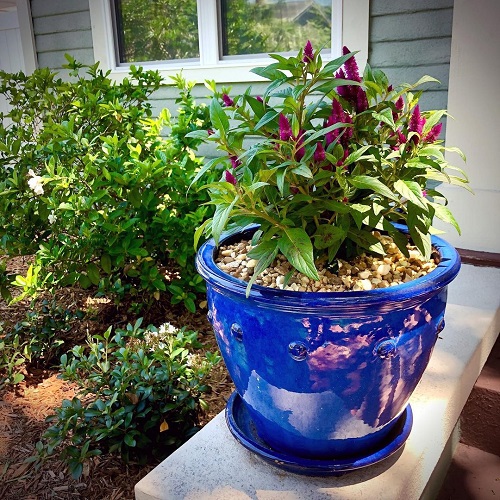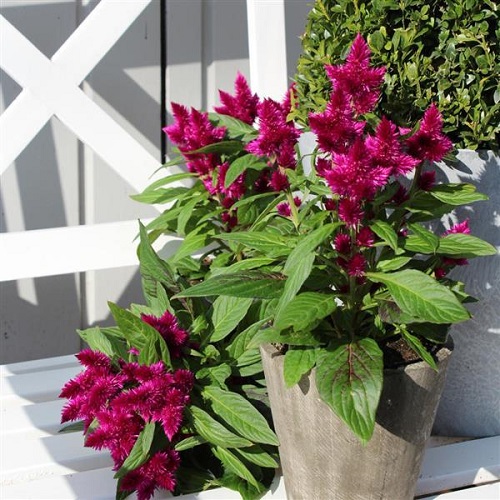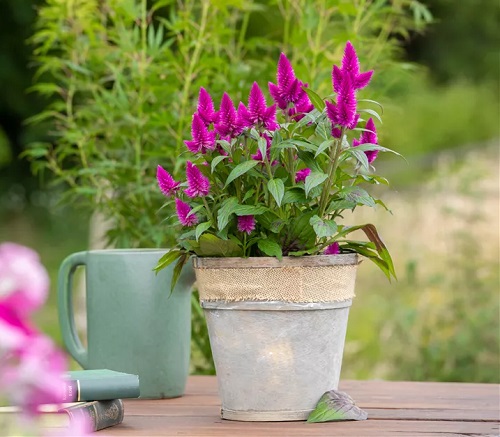Add some color and vibrancy to your garden by following our comprehensive Celosia Intenz growing guide.

Celosia Intenz is renowned for its vibrant colors and unique textures, making it a coveted addition to any garden. Here are all the details to grow it!
Check Out Boobie Cactus Care And Growing Guide Here
Celosia Intenz Plant Information
Celosia Intenzis popular for its captivating plumes that bear a resemblance to rooster combs, which gives rise to its common name, “Plumed Cockscomb.” This plant exhibits a robust, upright growth habit and reaches an impressive height of 12 to 18 inches (30 to 45 cm).
The blooms of Celosia Intenz showcase an array of striking colors, including vibrant shades of red, orange, yellow, and pink.
Apart from its unique appearance, Celosia Intenz possesses exceptional heat and drought tolerance, making it an ideal choice for gardens in warm climates. Thriving in full sun to partial shade, this plant adds a touch of brilliance to flower beds, borders, and containers, enhancing the overall aesthetic appeal of any garden.
Botanical Name: Celosia argentea
Common Names: Red Fox, Feather Cockscomb, Red Spinach, Plumed Cockscomb, Feathery Amaranth, Woolflower, Wild Cockscomb.
USDA Zones: 8-11
Here are Cordyline Hot Pepper Plant Information and Landscaping Uses
Propagating Celosia Intenz
The most effective and commonly used propagation method for Celosia Intenz is stem cuttings. To successfully propagate Celosia Intenz cuttings, follow these steps:
- Choose healthy stems from an established Celosia Intenz plant. The stems should be free from disease, pests, and damage.
- Using clean, sharp pruning shears, take 4-6 inch (10-15 cm) cuttings from the tips of the stems. Remove the lower leaves, leaving only a few leaves at the top.
- Dip the cut end of each cutting into a rooting hormone powder or gel to stimulate root development. This step is optional but can enhance the success rate of propagation.
- Insert the cuttings into a well-draining potting mix, ensuring the lower nodes are buried in the soil.
- Mist the Celosia Intenz cuttings with water and cover them with a plastic bag or a clear plastic dome to create a humid environment.
- Place the Celosia Intenz cuttings in a bright area with indirect light and maintain a temperature of around 70-75°F (21-24°C). Monitor the soil moisture and mist the cuttings when necessary to keep the humidity levels high.
- After a few weeks, check for root development by gently tugging on the cuttings.
- Once roots have formed, the cuttings can be transplanted into individual pots or containers and eventually moved to the garden once they have acclimated to outdoor conditions.
Propagate Any Plant Cutting Quickly Using this Trick
When to Plant Celosia Intenz
As an annual plant, Celosia Intenz completes its entire life cycle within a single growing season. The ideal time to plant Celosia Intenz is in the late spring after the last frost has passed and the soil has warmed up. In most regions, this typically falls between April and May.
Learn about Philodendron Caramel Marble Care and Growing Guide here
Requirements for Growing Celosia Intenz

Location
Celosia Intenz thrives in areas with a minimum of six hours of direct sunlight per day. Full sun exposure promotes vigorous growth and enhances flower production.
However, it can tolerate some shade, particularly during the hottest part of the day in regions with intense sunlight.
Soil
Celosia Intenz thrives in well-draining soil with a pH level between 6.0 and 7.5. Before planting, prepare the soil by removing any weeds or debris and incorporating organic matter such as compost or well-rotted manure.
Here are the best recipes to make the perfect growing medium for your plants
Organic matter improves soil fertility, enhances moisture retention, and provides essential nutrients. A loose and well-draining soil structure is vital to prevent waterlogged conditions, as Celosia Intenz is susceptible to root rot in excessively moist soil.
Watering
Water Celosia Intenz regularly enough to keep the soil moist, but not waterlogged. This often equates to watering once or twice a week, but can depend on your local climate and the time of year.
Here are the best ways to water plants
Before watering, check the soil by sticking your finger an inch or two into the soil. If it feels dry at that depth, it’s time to water.
Overwatering can lead to root rot. Make sure the plant is in well-draining soil and that any excess water can escape if you’re using a pot or container.
Temperature
Celosia Intenz does best in temperatures between 60-80 degrees Fahrenheit (15-27 degrees Celsius). They can tolerate higher temperatures if they’re watered adequately.
They are not frost-tolerant and should be brought indoors or protected if temperatures dip below freezing.
Celosia Intenz Care
Fertilizer
Celosia Intenz generally benefits from a balanced fertilizer, like a 10-10-10 (N-P-K) or similar ratio. This should be applied approximately once a month during the growing season.
Here are DIY Dandelion Fertilizer Recipes
Over-fertilizing can cause lush foliage growth at the expense of blooms, so moderation is key.
Deadheading
Regular deadheading is essential to encourage continuous blooming and maintain the plant’s appearance. As the flowers fade and begin to wither, remove them by cutting the stems just above a leaf node or a healthy set of leaves.
Deadheading prevents seed production and signals the plant to channel its energy into producing new blooms rather than setting seeds.
Pests and Diseases
The plant is relatively resistant to pests and diseases. However, occasional infestations of aphids or spider mites may occur. Regular monitoring of the plant is essential to detect and address pest issues promptly.
If aphids or spider mites are present, the use of insecticidal soap or neem oil is an effective and environmentally friendly method of control. Repeat the application as needed until the infestation is under control.
Here are the 40 Best Organic Pest Control Approaches Every Gardener Should Know
The most common diseases for Celosia Intenz are fungal in nature. Powdery mildew, leaf spot, and root rot can all affect these plants. Good preventative measures include providing proper air circulation, avoiding overhead watering, and promptly removing any fallen debris from around the plants.
Fungicides can help with serious infections, but it’s often easier and more effective to prevent these diseases than to treat them.




